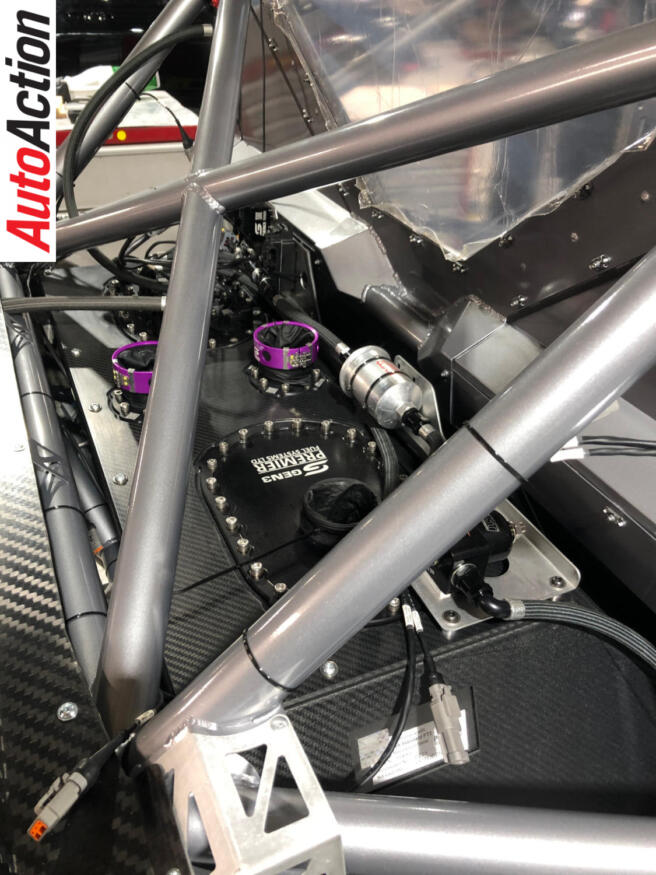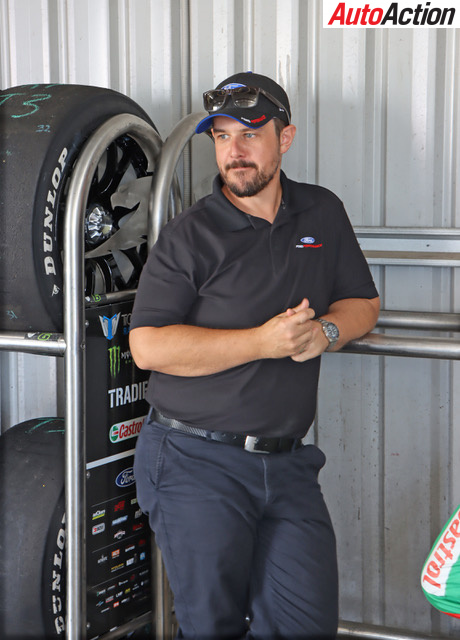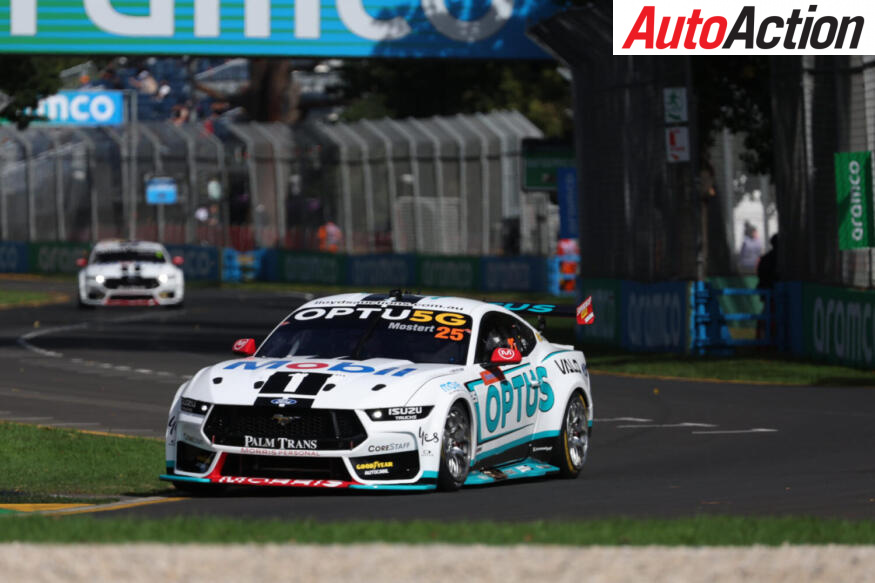SUPERCARS FORD MUSTANG… MORE PARITY ADJUSTMENTS

By Bruce Williams
Date posted: 28 April 2023
Following ongoing pressure from Ford and the Ford Supercar teams to address issues with low down engine power and torque delivery of the Ford Coyote engine, it has been confirmed that a new engine calibration has been fitted to the Ford Mustang ECU’s (Engine Control Units) ahead of this weekend’s Perth Supersprint event.
The change to the Ford engine mapping comes on top of last week’s change to the ‘Centre of Gravity’ (COG) position on the Chevrolet Camaro, which saw a 2.3mm average variance between the Mustang and the Camaro – with the Mustang having the higher average COG.
Following testing of Gen3 Supercars at Tickford Racing’s facility and evaluation of the results, it was concluded that all 14 Camaros would have weight redistributed in a move designed to raise their centre of gravity to match that of the Mustangs.
A total of 4.97kg of ballast was redistributed to the rear of the Camaros, slightly above and forward of the rear axle line-roughly in the area of the rear bulkhead.

The rear end of the Chevrolet Camaro where the parity adjustment has been made.
As has been reported in AUTO ACTION over past couple of months, the power delivery characteristics of the Ford engine has caused issues for the Gen3 Mustang drivers, who have complained about an inability to maintain traction out of low and medium speed corners once rear tyres have heated up.
Changes to improve the lowdown power delivery has been a focus for Ford’s engine developers, Herrod Performance Engines, who have been working on the issue since the February Supercars test day.
Prior to the Perth round Ford’s head of motorsport in Australia, Ben Nightingale, spoke to AUTO ACTION and confirmed that process was underway and was hopeful the proposed changes will be rolled out for Perth.

Ford Performance’s Ben Nightingale at Winton. Image: Bruce Williams
“We’ve got our engines on the dyno at HPE all the time, trialing things, trying to understand these engines more as the work goes on, then we’ve got to go through the process of applying to Supercars to implement it,” he said.
“Sometimes the simplest answer is the simplest answer, and we have been working through it all with Shane Howard and his team at Supercars.”
It is believed that late changes to the Ford Coyote engine mapping by the Supercars technical department caused the issue which created a ‘low throttle position stumble’ which drivers would have to ‘drive through’ and this was seen as a cause of rear drive instability.

At both Newcastle and Melbourne Chaz Mostert has lost race leads after reporting significant rear tyre degradation. Image: Mark Horsburgh-EDGE Photographics
The lack of rear traction or ‘power-down’ has been a major ongoing issue for parity between the two makes.
Despite a revised engine map being available to Ford teams since before the Australian Grand Prix round, under the rules of Gen3, Ford could not release a new engine map to its cars until Supercars had tested and approved the upgrade.
The Supercars technical team have now approved the downloading of the new Ford Coyote engine map which has been completed ahead of the first practice session later today.
Download the full Supercars Perth Round 3 Event Guide with track stats and facts and a full event schedule, plus our extensive driver profiles here

Perth SuperSprint Schedule, April 28-30, (all times AEST)
Friday
Practice (90 Minutes) – 16.25 – 17.55
Saturday
Qualifying (Race 7) – 13.10 – 14.05
Race 7 (42 laps) – 17.45 – 18.45
Sunday
Qualifying (Race 8) – 11.15 – 11.30
Qualifying (Race 9) – 11.40 – 11.55
Race 8 (42 laps) – 13.45 – 14.45
Race 9 (42 laps) – 17.45 – 18.45
For more of the latest motorsport news, pick up the latest issue of AUTO ACTION.
AUTO ACTION, Australia’s independent voice of motorsport
Recent Stories
array (
0 =>
WP_Term::__set_state(array(
'term_id' => 11,
'name' => 'Latest News',
'slug' => 'latest-news',
'term_group' => 0,
'term_taxonomy_id' => 11,
'taxonomy' => 'category',
'description' => '',
'parent' => 0,
'count' => 16801,
'filter' => 'raw',
'cat_ID' => 11,
'category_count' => 16801,
'category_description' => '',
'cat_name' => 'Latest News',
'category_nicename' => 'latest-news',
'category_parent' => 0,
)),
1 =>
WP_Term::__set_state(array(
'term_id' => 38,
'name' => 'Supercars',
'slug' => 'supercars',
'term_group' => 0,
'term_taxonomy_id' => 38,
'taxonomy' => 'category',
'description' => 'The Supercars Championship, currently known as the Repco Supercars Championship, is the premier motorsport category in Australasia and one of Australia\'s biggest sports. It originated from the Australian Touring Car Championship (ATCC), which held its first race in 1960 at Gnoo-Blas in Orange, New South Wales. The ATCC evolved over the years, and in 1997, it was rebranded as the V8 Supercars Championship, eventually becoming the Supercars Championship we know today.
Some of the leading drivers in the history of the Supercars Championship include Peter Brock, who is often referred to as the "King of the Mountain" for his nine victories at the Bathurst 1000, a race that is considered one of the biggest in the series. Other notable drivers include Dick Johnson, Marcos Ambrose, Craig Lowndes, Shane van Gisbergen, Jamie Whincup, who holds the record for the most championship titles, and Mark Skaife, who has also been a dominant force in the series.
The Bathurst 1000, held at Mount Panorama Circuit in Bathurst, New South Wales, is arguably the most famous race in the Supercars calendar. Other significant races include the Sandown 500 and the Adelaide 500, which are known for their challenging circuits and thrilling competitions.
The Supercars Championship has grown to become a globally recognized series, known for its competitive racing and passionate fan base. It continues to be a major part of Australia\'s motorsport culture, attracting top drivers and teams from around the world.',
'parent' => 0,
'count' => 5628,
'filter' => 'raw',
'cat_ID' => 38,
'category_count' => 5628,
'category_description' => 'The Supercars Championship, currently known as the Repco Supercars Championship, is the premier motorsport category in Australasia and one of Australia\'s biggest sports. It originated from the Australian Touring Car Championship (ATCC), which held its first race in 1960 at Gnoo-Blas in Orange, New South Wales. The ATCC evolved over the years, and in 1997, it was rebranded as the V8 Supercars Championship, eventually becoming the Supercars Championship we know today.
Some of the leading drivers in the history of the Supercars Championship include Peter Brock, who is often referred to as the "King of the Mountain" for his nine victories at the Bathurst 1000, a race that is considered one of the biggest in the series. Other notable drivers include Dick Johnson, Marcos Ambrose, Craig Lowndes, Shane van Gisbergen, Jamie Whincup, who holds the record for the most championship titles, and Mark Skaife, who has also been a dominant force in the series.
The Bathurst 1000, held at Mount Panorama Circuit in Bathurst, New South Wales, is arguably the most famous race in the Supercars calendar. Other significant races include the Sandown 500 and the Adelaide 500, which are known for their challenging circuits and thrilling competitions.
The Supercars Championship has grown to become a globally recognized series, known for its competitive racing and passionate fan base. It continues to be a major part of Australia\'s motorsport culture, attracting top drivers and teams from around the world.',
'cat_name' => 'Supercars',
'category_nicename' => 'supercars',
'category_parent' => 0,
)),
2 =>
WP_Term::__set_state(array(
'term_id' => 2029,
'name' => 'ZZZ-Email',
'slug' => 'email',
'term_group' => 0,
'term_taxonomy_id' => 2029,
'taxonomy' => 'category',
'description' => '',
'parent' => 2031,
'count' => 7357,
'filter' => 'raw',
'cat_ID' => 2029,
'category_count' => 7357,
'category_description' => '',
'cat_name' => 'ZZZ-Email',
'category_nicename' => 'email',
'category_parent' => 2031,
)),
3 =>
WP_Term::__set_state(array(
'term_id' => 2031,
'name' => 'ZZZ-RSSFeeds',
'slug' => 'zzz-rssfeeds',
'term_group' => 0,
'term_taxonomy_id' => 2031,
'taxonomy' => 'category',
'description' => '',
'parent' => 0,
'count' => 6712,
'filter' => 'raw',
'cat_ID' => 2031,
'category_count' => 6712,
'category_description' => '',
'cat_name' => 'ZZZ-RSSFeeds',
'category_nicename' => 'zzz-rssfeeds',
'category_parent' => 0,
)),
)










